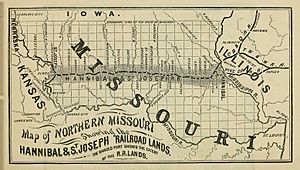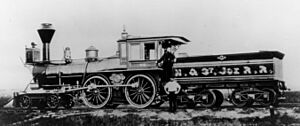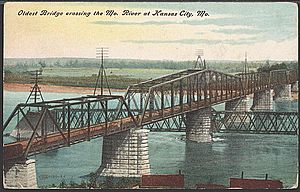Hannibal and St. Joseph Railroad facts for kids

Hannibal and St. Joseph Railroad, 1860
|
|
| Overview | |
|---|---|
| Locale | Missouri |
| Dates of operation | 1846–1883 |
| Successor | Chicago, Burlington and Quincy Railroad |
| Technical | |
| Track gauge | 4 ft 8 1⁄2 in (1,435 mm) standard gauge |
The Hannibal and St. Joseph Railroad was a very important railway line in Missouri. It was the first railroad to cross the entire state! It started in Hannibal, Missouri in the northeast and went all the way to St. Joseph, Missouri in the northwest.
This railroad is famous for carrying the very first letter for the Pony Express. This happened on April 3, 1860. The letter was carried by a train pulled by a locomotive named Missouri. The railroad connected two of Missouri's biggest cities before the American Civil War.
Contents
Building the Railroad: A Look Back to the 1850s
How the Railroad Got Started
The idea for the Hannibal and St. Joseph Railroad began in 1846. A meeting was held in Hannibal, at the office of John Marshall Clemens. He was the father of the famous writer, Mark Twain.
Construction on the railroad officially started in 1851. Workers began building from both Hannibal and St. Joseph at the same time. To pay for this huge project, the railroad received money from counties along the route. They also got a gift of 600,000 acres (about 2,400 square kilometers) of land from the United States Congress.
Connecting the Tracks
The two parts of the railroad, built from opposite ends, finally met in Chillicothe, Missouri. This exciting event happened on February 13, 1859. A special marker was placed at this spot by the railroad. This marker was found again in 2009 at a museum in Galesburg, Illinois.
The railroad line stretched westward from Hannibal. It passed through many Missouri cities. These included Palmyra, Monroe City, Shelbina, Macon, Brookfield, Chillicothe, Hamilton, and Cameron. Finally, it reached St. Joseph.
Famous People and the Railroad
Even before he became a well-known sculptor, John Rogers worked on the railroad. He was a mechanic there in 1856 and 1857. Later, in 1859, Abraham Lincoln rode on this railroad. He was on his way to give a speech in Council Bluffs, Iowa.
During the American Civil War, one of Ulysses S. Grant's first jobs was to protect this railroad. He also protected the Pony Express mail. Grant was later promoted to a higher rank in August 1861.
A Difficult Time: The Platte Bridge Incident
Soon after Grant left, the railroad faced a terrible event. On September 3, 1861, a group of attackers burned a bridge over the Platte River. This caused a train to crash. Between 17 and 20 people died, and 100 more were hurt. This sad event is known as the Platte Bridge Railroad Tragedy.
New Ideas: Post Offices on Wheels
Mail Delivery on Trains
In 1862, a new idea for delivering mail was tried out. It was called "post offices on wheels." William A. Davis started this experiment between Hannibal and St. Joseph. The goal was to make mail delivery faster. This was especially important for connecting with the overland stagecoach, which had replaced the Pony Express.
The Hannibal and St. Joseph Railroad helped by changing a baggage car for Davis. It had a table and many small slots for letters, just like a post office. Davis would get on the train and sort the mail while it was moving. He would prepare letters for California and other places. This made mail delivery much quicker.
Challenges and Success
However, the railroad faced many problems during the Civil War. There were attacks and not enough repairs. Because of these issues, the "post offices on wheels" experiment had to stop for a while. After the war, this type of mail service started again. It became known as the Chicago & Kansas City Railway Post Office.
Building the Hannibal Bridge
In 1867, a group of businessmen convinced the railroad to build a shortcut to Kansas City, Missouri. The railroad built a new line and a very important bridge. This was the Hannibal Bridge over the Missouri River in Kansas City. It was 1,371 feet (418 meters) long.
The Hannibal Bridge opened on July 3, 1869. It was the very first railroad bridge to cross the Missouri River. This bridge created a direct link between Chicago and Texas. It also helped Kansas City become the most important city in the region. Before this, other cities like Leavenworth, Kansas or St. Joseph were considered more important.
The Railroad's Later Years
Becoming Part of a Bigger Company
The Chicago, Burlington and Quincy Railroad often used the Hannibal and St. Joseph Railroad for its trains going to Chicago. In 1883, the Chicago, Burlington and Quincy Railroad bought the Hannibal and St. Joseph Railroad. The connection between Hannibal and St. Joseph remained in use for about 125 years.
On March 2, 1970, the railroad became part of a new company called Burlington Northern. This happened when the Chicago, Burlington and Quincy Railroad merged with three other railway companies.
Changes Over Time
In the mid-1980s, the railroad stopped service on the western part of the line, from Brookfield to St. Joseph. Today, only a small section of track remains between Brookfield and Laclede. This part is mostly used to store extra rail cars by the BNSF Railway.
The tracks from Laclede westward to St. Joseph are no longer there. However, the tracks from Brookfield eastward towards the Mississippi River are still used by BNSF. Some tracks near St. Joseph are also still in use. A small part of the track near the Platte River is now owned by Herzog Contracting.



